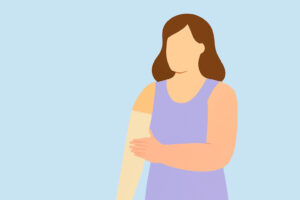Managing lymphedema requires a comprehensive approach that includes meticulous skin care. Proper skin care is vital for preventing infections, reducing complications, and improving the quality of life for individuals with lymphedema. This article provides essential skin care tips and emphasizes the importance of early screening and advanced treatments like lymphovenous bypass (LVB) for effective lymphedema management.
What are the Basics of Lymphedema Skin Care?
Why is proper skin care important for lymphedema patients?
Proper skin care is crucial for lymphedema patients to prevent infections, which can exacerbate swelling and lead to severe complications. Lymphedema causes the skin to become fragile and more susceptible to injuries and infections like cellulitis. Maintaining healthy skin integrity helps reduce these risks and promotes overall well-being.
How often should you practice skincare routines?
Lymphedema patients should practice daily skincare routines. These include gentle cleansing, moisturizing, and inspecting the skin for any signs of damage or infection. Consistent daily routines help keep the skin in optimal condition and prevent the buildup of bacteria and other pathogens that can cause infections.
What are the best self-care practices for lymphedema?
Best self-care practices for lymphedema include:
- -Use cleansing with mild, fragrance-free soaps.
- -Applying emollient-rich moisturizers to maintain skin hydration.
- -Avoiding extreme temperatures that can dry out the skin.
Patients should also avoid tight clothing and jewelry that can restrict lymph flow and cause skin irritation. Regularly inspecting the skin for cuts, blisters, or signs of infection is essential for early intervention.
Preventing Infections in Lymphedema?
What are the common signs of infection in lymphedema?
Common signs of infection in lymphedema include redness, warmth, swelling, pain, and the presence of pus or other discharge. Fever and chills may also indicate a systemic infection. Recognizing these signs early and seeking prompt medical attention can prevent the infection from spreading and causing further complications.
What hygiene tips can help reduce the risk of infection?
Maintaining good hygiene is crucial for reducing the risk of infection in lymphedema patients. This includes regular hand washing, keeping the affected limb clean and dry, and using antiseptic solutions to clean any cuts or abrasions. Avoiding shared personal items and using clean towels and linens can also help prevent the spread of bacteria and other pathogens.
How can good skin care prevent skin breakdown?
Good skin care helps maintain the skin’s barrier function, preventing skin breakdown and ulceration. Moisturizing the skin regularly prevents dryness and cracking, while gentle cleansing removes dirt and bacteria. Protecting the skin from injuries and irritants, such as harsh chemicals or rough fabrics, is also essential in preventing skin breakdown.
What Compression Techniques Are Effective?
How do compression garments be used properly?
Compression garments are a cornerstone of lymphedema management. To use them effectively, patients should ensure a proper fit, wear them consistently as prescribed, and replace them regularly as they lose elasticity over time. Proper donning and doffing techniques are crucial to avoid skin damage and ensure optimal compression.
Can compression help in reducing swelling?
Yes, compression garments help reduce swelling by applying consistent pressure to the affected limbs, promoting lymphatic fluid movement, and preventing fluid buildup. They are most effective when used in conjunction with other treatments, such as manual lymphatic drainage (MLD) and regular exercise.
What to know about cleaning and maintaining your compression garment?
Cleaning and maintaining compression garments are essential for their longevity and effectiveness. Patients should follow the manufacturer’s instructions for washing, typically using mild detergents and avoiding fabric softeners. Garments should be air-dried to preserve their elasticity. Regular inspections for signs of wear and tear are important, and garments should be replaced as needed.
Why is Manual Lymphatic Drainage Important?
What is manual lymphatic drainage?
Manual lymphatic drainage (MLD) is a specialized massage technique that stimulates the lymphatic system and promotes the flow of lymph fluid. It involves gentle, rhythmic movements that encourage the drainage of lymphatic fluid from the affected areas to healthier lymph nodes, where it can be processed and eliminated from the body.
How can it help in lymphedema management?
MLD helps reduce swelling, alleviate discomfort, and improve the overall function of the lymphatic system. It is particularly effective when combined with other treatments, such as compression therapy and exercise. MLD can also prevent the progression of lymphedema and reduce the risk of infections and other complications.
How Can Nutrition Aid in Lymphedema Skin Care?
What foods reduce swelling?
Certain foods have anti-inflammatory properties that can help reduce swelling in lymphedema patients. These include fruits and vegetables rich in antioxidants (such as berries, leafy greens, and citrus fruits), fatty fish high in omega-3 fatty acids (like salmon and mackerel), and nuts and seeds. Reducing salt intake can also help prevent fluid retention.
How to maintain a healthy weight?
Maintaining a healthy weight is crucial for lymphedema management. Excess weight can increase pressure on the lymphatic system and worsen swelling. A balanced diet that includes lean proteins, whole grains, and plenty of fruits and vegetables, combined with regular physical activity, can help achieve and maintain a healthy weight.
How can a balanced diet aid lymphatic health?
A balanced diet supports overall lymphatic health by providing essential nutrients that promote immune function and reduce inflammation. Adequate hydration is also important, as it helps maintain lymph fluid balance and supports the lymphatic system’s function. Patients should focus on a diet rich in vitamins, minerals, and antioxidants to support their overall health and well-being.
How to Protect Your Skin from Damage?
What are some preventive measures to avoid skin damage?
Preventive measures to avoid skin damage include using gentle skin care products, moisturizing regularly, and protecting the skin from cuts, scrapes, and insect bites. Wearing protective clothing, using sunscreen, and avoiding extreme temperatures can also help maintain skin integrity. Patients should be cautious with activities that could cause skin injuries, such as gardening or using sharp tools.
What insect repellent should you use?
When choosing an insect repellent, patients should opt for products that are effective yet gentle on the skin. Repellents containing DEET, picaridin, or oil of lemon eucalyptus are effective against insect bites. It is important to follow the instructions for use and reapply as needed, especially when spending time outdoors.
How do you keep your skin clean and healthy?
Keeping the skin clean and healthy involves regular cleansing with mild, fragrance-free soaps, moisturizing daily, and avoiding irritants that can cause dryness or irritation. Patients should inspect their skin daily for signs of damage or infection and address any issues promptly. Using hypoallergenic products and wearing soft, breathable fabrics can also help maintain healthy skin.
Conclusion
Proper skin care is essential for managing lymphedema effectively. By incorporating daily skincare routines, practicing good hygiene, using compression garments correctly, and maintaining a healthy diet, patients can reduce the risk of infections and complications. Early screening and advanced treatments like lymphovenous bypass (LVB) play a crucial role in improving outcomes. A comprehensive approach that includes patient education and support from a multidisciplinary care team can significantly enhance the quality of life for individuals living with lymphedema.
FAQ:
Q: What is lymphedema?
A: Lymphedema is a condition characterized by limb swelling due to a lymphatic system blockage.
Q: How can I manage lymphedema effectively?
A: Managing lymphedema involves consistent self-care practices, including skincare and hygiene, as well as seeking treatment from healthcare professionals.
Q: Why are skin care and hygiene important for individuals with lymphedema?
A: Proper skin care and hygiene are crucial for those with lymphedema as they can help reduce the risk of developing infections and complications associated with the condition.
Q: What are some symptoms of lymphedema that I should be aware of?
A: Symptoms of lymphedema include swelling in the limbs, skin discoloration, skin folds, and a feeling of heaviness or tightness in the affected limb.
Q: How can I reduce my risk of developing infections related to lymphedema?
A: Maintaining good skin hygiene, drying your skin thoroughly, and avoiding activities that may damage the skin can reduce the risk of infection associated with lymphedema.
Q: What role does skin care play in managing lymphedema?
A: Proper skin care plays a vital role in managing lymphedema by preventing skin damage, reducing the risk of infections, and promoting overall skin health.
Q: Is there a lymphoedema support network available for individuals dealing with the condition?
A: Yes, there are lymphedema support networks where individuals can find resources, support, and guidance on managing their lymphedema effectively.





